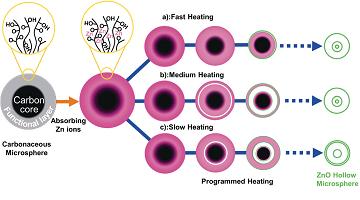Hollow micro-/nano-structured materials are now playing an important role in cutting edge innovations for energy conversion and storage, catalysis, chemical sensors, and drug delivery systems. ZnO with micrometer-sized hollow structure is an important photoanode material in the applications of dye-sensitized solar cells (DSSCs) because of its wide band gap (3.37?eV) and high electron mobility (115–155?cm2V?1s?1), in addition, the unique structure provides an enhanced surface-to-volume ratio and reduced transport lengths for both mass and charge transport. However, the structure of hollow materials on the micro- and nano-scale is difficult to manipulate accurately by most of the present methods, the energy conversion efficiency of DSSCs using ZnO hollow microspheres as the photoanodes is difficult to reach the anticipation effect.
Recently, Professor WANG Dan from Institute of Process Engineering (IPE) and his group have developed a general sequential templating approach to prepare multi-shelled hollow metal oxide microspheres by utilizing solid carbonaceous microspheres as the templates to adsorb metal ions followed by heating process (Angew. Chem. Int. Ed., 2011, 50, 2738-2741). Furthermore, the inter-shell spacings of ZnO hollow microspheres can be rationally designed by adjusting the programmable heating processes (Figure 1). Beside the number of shells, the inter-shell spacings have important impact on the energy conversion efficiency of DSSCs based on ZnO hollow microspheres (Figure 2). Due to the large surface areas and the ability to reflect and scatter light, ZnO hollow microspheres with close double shells in the exterior possess higher energy conversion efficiency. Especially, the quadruple-shelled hollow microspheres with close double shells in the exterior and double-shelled hollow cores show a high energy conversion efficiency of 5.6%.
The research find a new route for fabricating high efficiency DSSCs based on structural design and manipulation of hollow microspheres. This work has been recently published in Advanced Materials(Adv. Mater., 2012, DOI: 10.1002/adma.201104626).

Figure 1 Illustration of the formation of multishelled ZnO hollow microspheres through different heating processes.(image by IPE)

Figure 2 A) J–V curves of DSSCs based on ZnO hollow microspheres: a) single-shelled, b) double-shelled, c) triple-shelled, d) quadruple-shelled, e) double-shelled (with close double shells in the exterior), f) triple-shelled (with close double shells in the exterior and smaller hollow core) and g) quadruple-shelled (with close double shells in the exterior and double-shelled hollow core). B) Corresponding UV/vis diffuse reflectance spectra. The inset in B is the schematic drawing for quadruple-shelled (with close double shells in the exterior and double-shelled hollow core). (image by IPE)
 Search
Search




 京公网安备110402500047号
京公网安备110402500047号